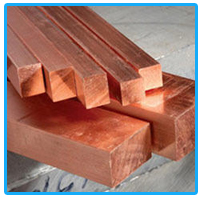Products
BLOCK, ROD ,ROUND BAR,ROLLED BAR, SQUARE , HEX ,STRIPS, FLAT, ,RECTANGLES.

Chromium copper alloys are high copper alloys, containing 0.6 to 1.2% cr. the chromium copper alloys are used for their high strength, corrosion resistance and electrical conductivity. the chromium copper alloys are age hardenable, which, in this case, means that a change in properties occurs at elevated temperature due to the precipitation of chromium out of the solid solution. the strength of fully aged chromium copper is nearly twice that of pure copper and its conductivity remains high at 85% iacs, or 85% that of pure copper. these high strength alloys retain their strength at elevated temperatures. the corrosion resistance of chromium copper alloys is better than that of pure copper because chromium improves the chemical properties of the protective oxide film. chromium copper has excellent cold formability and good hot workability. it is used in applications such as resistance welding electrodes, seam welding wheels, switch gears, cable connectors, circuit breaker parts, molds, spot welding tips, and electrical and thermal conductors that require strength. chromium copper alloys are designated as uns c18050 through c18600; the cast alloys are c81400 through c81540.
The age hardening reaction occurs because the solid solubility of chromium in copper decreases as the temperature decreases. the structure of slow cooled chromium copper is a two phase mixture of chromium and alpha copper. superior mechanical properties are achieved by fast-cooling the chromium copper alloys from the annealing temperature, so the chromium remains in a supersaturated solid solution with the copper. followed by an aging treatment where the chromium precipitates from the solid solution forming a very fine dispersion of precipitates in the matrix. the microstructure of a quenched or quickly cooled chromium copper alloy appears similar to that of the unalloyed copper. a fast cool prevents the chromium from precipitating out of the solid solution, so the resulting cast structure consists of a single phase alpha copper structure. the first material to solidify is pure copper, followed by a eutectic mixture of alpha and chromium. the alpha and chromium eutectic material forms a lamellar structure in the interdendritic regions. the microstructure of the wrought alloy consists of equiaxed, twinned grains of alpha copper solid solution. typically the allow are cooled rapidly so the chromium remains in alpha copper solid solution. the tempering treatment allows the chromium to precipitate out of solution forming a dispersion of chromium precipitates throughout the matrix. the chromium precipitates, or hardening precipitates, can be very fine and may not be visible at low magnifications.
Products
WIRE ,BLOCK, ROD ,ROUND BAR, ROLLED BAR, SQUARE , FLAT,FOIL, SHEET , PLATE, SCRAP, INGOT ,RING, BUSHES, DISC
Chromium zirconium copper alloy are composited by three material. and the common chemical composition of this alloy is 0.5~1.2% chromium, 0.03~0.3% zirconium and the other is copper. cu.cr.zr. is often the best choice for applications where a combination of high electrical and thermal conductivity and high strength at higher temperatures is required. studies have shown that of all commercially available electrode materials for spot welding mid stee, the lowest electrode costs are obtained with chromium-zirconium copper. the properties of cu-cr-zr are obtained by alloying and through heat treatments combined with cold working. the metallurgical behaviour of this alloy is based on transformations at the atomic level.

Chromium zirconium copper alloy is used widely in areas where high electrical and thermal conductivity are required combined with good mechanical properties. this is a high strength, seam, high conductivity alloy for spot, butt and projection welding which is ideal for plain as well as coated and galvanized sheets. uses include resistance welding machine electrodes, seam welding wheels, spot welding tips, flash butt welding electrodes, anvil contact bars, electrical switch gear contacts & terminals, electrode holders, cable connectors, current carrying arms and shafts, circuit breaker parts, heat sinks, short circuit rings, mig welding contact tubes and many other applications where copper would normally be the ideal choice for high conductivity but is just not strong enough.
C18150 chromium zirconium copper is used extensively for cap style resistance welding electrodes. evidence suggests that it can provide less sticking and resist deformation longer than its chromium copper counterpart in some specific situations.
ProductionThe first heat treatment stage is solution annealing at approximately 1000 °c. at this temperature the chromium and zirconium atoms are randomly distributed in the copper matrix. the material is then quenched in water. between 400 and 700 °c the chromium and zirconium atoms have a tendency to form precipitates in the copper matrix, but the cooling is too rapid for precipitation to take place. the result is a supersaturated solid solution. the strength of this structure is only slightly higher than that of pure copper and foreign atoms in the copper matrix considerably reduce the electrical conductivity.
The supersaturated solid solution serves as a starting point for further heat treatments. The properties of cu.cr.zr. are achieved by ageing the material at a temperature below 500 °c.The ageing conditions are very critical and are chosen so that the precipitations are coherent with the copper matrix, i.e. the atomic layers of copper continue through the precipitations. although the atomic layers continue through the boundary of precipitates the lattices on both sides of the boundary do not match each other completely. this mismatch causes strain which is responsible for the high mechanical strength.
Another consequence of ageing is that, as the number of foreign atoms in the matrix decreases the electrical conductivity becomes considerably higher. the mechanical properties of cu.cr.zr. are further improved by introducing a cold working process between solution annealing and ageing.





